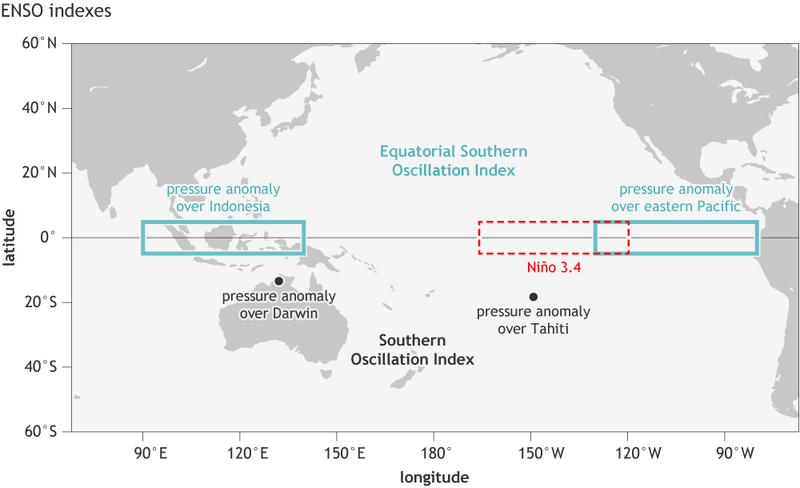Image: Fig4a ENSOindices Nino3.4only large

Description: The oldest indicator of the ENSO state is the Southern Oscillation Index (SOI): the difference between the atmospheric pressure at sea level at Tahiti and at Darwin (1); see Fig. 1. A seesaw in pressure at these locations reflects the atmospheric component of ENSO, discovered in the early 1900s by Walker and Bliss (1932) and others. During El Niño, the pressure becomes below average in Tahiti and above average in Darwin, and the Southern Oscillation Index is negative. During La Niña, the pressure behaves oppositely, and the index becomes positive. The fact that the SOI is based on the sea level pressure at just two individual stations means it can be affected by shorter-term, day-to-day or week-to-week fluctuations unrelated to ENSO. But averaging the index values over months or seasons helps to isolate more sustained deviations from the average, like those associated with ENSO. Another limitation of the Southern Oscillation Index is that both Tahiti and Darwin are located somewhat south of the equator (Tahiti at 18˚S, Darwin at 12˚S), while the ENSO phenomenon is focused more closely along the equator. The Equatorial Southern Oscillation Index overcomes this problem, as it uses the average sea level pressure over two large regions centered on the equator (5˚S to 5˚N) over Indonesia and the eastern equatorial Pacific (see Fig. 2). However, data for this index only extend back to 1949 (2). In contrast, the Tahiti-Darwin index goes back to the late 1800s because of longer station records. Due to its longer records, the Tahiti-Darwin index was used to represent the ENSO state in a set of landmark studies relating ENSO to its global climate effects (Ropelewski and Halpert 1986, 1987, among others).
Title: Fig4a ENSOindices Nino3.4only large
Credit: https://www.climate.gov/news-features/blogs/enso/why-are-there-so-many-enso-indexes-instead-just-one
Author: Anthony Barnston
Usage Terms: Public domain
License: Public domain
Attribution Required?: No
Image usage
The following page links to this image:

